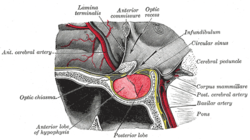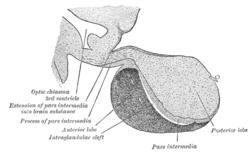Pituitary gland
| Pituitary gland | |
|---|---|
 |
|
| Located at the base of the brain, the pituitary gland is protected by a bony structure called the sella turcica (also known as turkish saddle) of the sphenoid bone. | |
 |
|
| Median sagittal through the hypophysis of an adult monkey. Semidiagrammatic. | |
| Latin | hypophysis, glandula pituitaria |
| Gray's | subject #275 1275 |
| Artery | superior hypophyseal artery, infundibular artery, prechiasmal artery, inferior hypophyseal artery, capsular artery, artery of the inferior cavernous sinus[1] |
| Precursor | neural and oral ectoderm, including Rathke's pouch |
| MeSH | Pituitary+Gland |
| Dorlands/Elsevier | Pituitary gland |
In vertebrate anatomy the pituitary gland, or hypophysis, is an endocrine gland about the size of a pea and weighing 0.5 g (0.02 oz.). It is a protrusion off the bottom of the hypothalamus at the base of the brain, and rests in a small, bony cavity (sella turcica) covered by a dural fold (diaphragma sellae). The pituitary fossa, in which the pituitary gland sits, is situated in the sphenoid bone in the middle cranial fossa at the base of the brain. The pituitary gland secretes hormones regulating homeostasis, including tropic hormones that stimulate other endocrine glands. It is functionally connected to the hypothalamus by the median eminence via a small tube called the Pituitary Stalk. It is considered to be the "master gland".
There is an analogous structure in the octopus brain.[2]
Contents |
Sections
The pituitary gland is composed of two lobes: The anterior pituitary (adenohypophysis) and the posterior pituitary (neurohypophysis). The pituitary gland is functionally linked to the hypothalamus by the pituitary stalk (also named the "infundibular stalk", or simply the "infundibulum")[1]. It is from the hypothalamus that hypothalamic releasing factors are released to descend down the pituitary stalk and to the pituitary gland where they stimulate the release of pituitary originating hormones. While the pituitary gland is known as the 'master' endocrine gland, both of its lobes are under the control of the hypothalamus. Glands that are controlled/affected by the pituitary gland's released hormones are called 'target glands'.
Anterior pituitary (Adenohypophysis)
The anterior pituitary synthesizes and secretes the following important endocrine hormones:
- Adrenocorticotropic hormone (ACTH),
- Thyroid-stimulating hormone (TSH),
- Growth hormone (also referred to as 'Human Growth Hormone', 'HGH' or simply, 'GH'),
- Prolactin (PRL), also known as 'Luteotropic' hormone (LTH),
the two 'Gonadotropins';
- Lutenizing hormone (also referred to as 'Lutropin' or 'LH', or in males, 'Interstitial Cell Stimulating Hormone' (ICSH)), and
- Follicle stimulating hormone (FSH),
as well as an
- endorphin called 'beta endorphin' and
- melanocyte–stimulating hormones (MSH's, or "intermedins").
These hormones are released from the anterior pituitary under the influence of the hypothalamus. Hypothalamic hormones are secreted to the anterior lobe by way of a special capillary system, called the hypothalamic-hypophyseal portal system.
The anterior pituitary is divided into anatomical regions known as the pars tuberalis, pars intermedia, and pars distalis. It develops from a depression in the dorsal wall of the pharynx (stomodial part) known as Rathke's pouch.
Posterior pituitary (Neurohypophysis)
The posterior pituitary stores and releases:
- Oxytocin, most of which is released from the paraventricular nucleus in the hypothalamus
- Antidiuretic hormone (ADH, also known as vasopressin and AVP, arginine vasopressin), the majority of which is released from the supraoptic nucleus in the hypothalamus
Oxytocin is one of the few hormones to create a positive feedback loop. For example, uterine contractions stimulate the release of oxytocin from the posterior pituitary, which, in turn, increases uterine contractions. This positive feedback loop continues throughout labor.
Intermediate lobe
There is also an intermediate lobe in many animals. For instance, in fish, it is believed to control physiological color change. In adult humans, it is just a thin layer of cells between the anterior and posterior pituitary. The intermediate lobe produces melanocyte-stimulating hormone (MSH), although this function is often (imprecisely) attributed to the anterior pituitary.
Variations among vertebrates
The pituitary gland is found in all vertebrates, but its structure varies between different groups.
The division of the pituitary described above is typical of mammals, and is also true, to varying degrees, of all tetrapods. However, only in mammals does the posterior pituitary have a compact shape. In lungfishes it is a relatively flat sheet of tissue lying above the anterior pituitary, and in amphibians, reptiles and birds, it becomes increasingly well developed. The intermediate lobe is generally not well developed in tetrapods, and is entirely absent in birds.[3]
Apart from lungfishes, the structure of the pituitary in fish is generally different from that in tetrapods. In general, the intermediate lobe tends to be well developed, and may equal the remainder of the anterior pituitary in size. The posterior lobe typically forms a sheet of tissue at the base of the pituitary stalk, and in most cases sends irregular finger-like projection into the tissue of the anterior pituitary, which lies directly beneath it. The anterior pituitary is typically divided into two regions, a more anterior rostral portion and a posterior proximal portion, but the boundary between the two is often not clearly marked. In elasmobranchs there is an additional, ventral lobe beneath the anterior pituitary proper.[3]
The arrangement in lampreys, which are amongst the most primitive of all fish, may indicate how the pituitary originally evolved in ancestral vertebrates. Here, the posterior pituitary is a simple flat sheet of tissue at the base of the brain, and there is no pituitary stalk. Rathke's pouch remains open to the outside, close to the nasal openings. Closely associated with the pouch are three distinct clusters of glandular tissue, corresponding to the intermediate lobe, and the rostral and proximal portions of the anterior pituitary. These various parts are separated by meningial membranes, suggesting that the pituitary of other vertebrates may have formed from the fusion of a number of separate, but closely associated, glands.[3]
Most fish also possess a urophysis, a neural secretory gland very similar in form to the posterior pituitary, but located in the tail and associated with the spinal cord. This may have a function in osmoregulation.[3]
Functions
Hormones secreted from the pituitary gland help control the following body processes:
- Growth Excess of HGH can lead to gigantism.
- Blood pressure
- Some aspects of pregnancy and childbirth including stimulation of uterine contractions during childbirth
- Breast milk production
- Sex organ functions in both men and women
- Thyroid gland function
- The conversion of food into energy (metabolism)
- Water and osmolarity regulation in the body
- Secretes ADH (antidiuretic hormone) to control the absorption of water into the kidneys
- Temperature regulation
Additional images
 Location of the pituitary gland in the human brain |
 Pituitary and pineal glands |
 The arteries of the base of the brain. |
 Mesal aspect of a brain sectioned in the median sagittal plane. |
 Pituitary |
See also
- Pituitary disease
- Head and neck anatomy
- Dantian
References
- ↑ Gibo H, Hokama M, Kyoshima K, Kobayashi S (1993). "[Arteries to the pituitary]". Nippon Rinsho 51 (10): 2550–4. PMID 8254920.
- ↑ http://www.nature.com/nature/journal/v222/n5190/abs/222293a0.html
- ↑ 3.0 3.1 3.2 3.3 Romer, Alfred Sherwood; Parsons, Thomas S. (1977). The Vertebrate Body. Philadelphia, PA: Holt-Saunders International. pp. 549–550. ISBN 0-03-910284-X.
External links
- NeuroNames hier-382
- Histology at BU 14201loa
- The Pituitary Gland, from the UMM Endocrinology Health Guide
- Oklahoma State, Endocrine System
- Pituitary apoplexy mimicking pituitary abscess
|
|||||||||||||||||||||||||||||||||||||||||||||||||||||||||||||
|
||||||||||||||||||||||||||||||||||||||||||||||
|
||||||||||||||||||||||||||||||||||||||||||||||||||||||||||